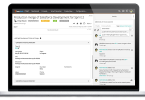Automation and orchestration are often used interchangeably. They’re both essential for digital transformation, but their scope and impact differ significantly. Treating them as the same is like assuming cooking a meal is the same as running a restaurant, or sending an email is the same as managing an entire marketing campaign.
In this post, we’ll explore the key differences between automation and orchestration, clarify the role of workload automation, and share guidance on selecting the best approach for your pipelines and deployments.
What is automation? The engine of individual task repetition
Automation uses technology to perform repetitive, rule-based tasks with minimal human intervention — ensuring they run reliably and consistently. It’s the foundation of operational efficiency.
Examples include:
- A nightly job that compiles and sends a report
- A shell script that provisions a single VM
- A Python script that extracts data from an API every hour
Why it matters: Automation reduces manual effort and human errors, standardizes repeatable tasks and speeds up delivery. For Data and DevOps teams, it directly impacts the speed, reliability and scalability of their workflows — providing some unique advantages.
For Data teams, automation provides the following advantages:
- Data pipeline efficiency: Automation can ensure ETL (Extract, Transform, Load) processes run consistently without manual intervention, reducing delays in data availability.
- Error reduction: Manual steps in data preparation or reporting can introduce human error, while automated processes can help ensure accuracy and consistency.
- Scalability: As data volumes grow, automated workflows can handle ingestion and transformation without extra effort.
- Faster insights: Automated data refresh and reporting mean analysts can spend less time on prep and more time on analysis.
For DevOps teams, automation provides the following advantages:
- Continuous Integration/Continuous Deployment (CI/CD): Automation can enable rapid code integration, testing and deployment, reducing release cycles from weeks to hours.
- Infrastructure as Code (IaC): Automating the provisioning of infrastructure can ensure environments remain consistent and easily reproducible.
- Reliability and monitoring: Automated health checks, rollbacks and alerts can minimize downtime and improve system resilience.
But automation has limits. It doesn’t inherently manage dependencies across tasks. For example, if Task B depends on Task A finishing successfully, basic automation won’t automatically execute on that relationship. You’d have to manually script or configure those dependencies. Also, with automation, visibility can be limited to “did the task run or fail?” You won’t get deeper insights like “why did it fail?”
What is orchestration? The coordinator of automated tasks
Orchestration goes beyond simple automation, taking it to the next level. While automation handles individual tasks, orchestration coordinates multiple tasks into a dependency-aware, resilient, end-to-end process. It ensures specific tasks run in the right order, across multiple business and IT systems, with conditions and dependencies managed automatically.
In Data and DevOps, orchestration is critical for functions such as integrating pipelines, deploying applications and synchronizing infrastructure at scale.
Examples:
- A data pipeline that ingests, cleans, validates, loads data into a warehouse and triggers dashboards only after upstream steps succeed
- A CI/CD workflow that builds, tests, scans, deploys and verifies releases using canary or blue-green strategies
- A Kubernetes cluster managing container scheduling, scaling and health checks
Why it matters: Orchestration delivers end-to-end visibility, error handling and governance at scale — essential for complex processes that span systems or require complex logic. Think of the series of tasks involved in onboarding a new employee: provisioning accounts, ordering hardware, setting up security and scheduling training — often across multiple teams and systems, across otherwise isolated silos. Orchestration synchronizes these different actions, ensuring they happen in the correct sequence, with the right information and within defined service level agreements (SLAs).
Orchestration becomes essential when:
- Your processes involve complex interdependencies, where tasks in one system trigger or depend on others.
- You have heterogeneous environments that combine legacy systems, modern microservices, cloud platforms and on-prem infrastructure.
- You have dynamic workflows that adapt to real-time data or business rules.
- You need real-time visibility and control to monitor and intervene across the entire process.
- You want service delivery automation, such as automatically provisioning and de-provisioning resources.
Orchestration matters because it addresses the complexity of interconnected workflows. But there are considerations. Orchestrated workflows can require more effort to design and maintain, along with thoughtful governance to ensure reliability and scalability.
The key differences: A side-by-side comparison
| Dimension | Automation | Orchestration |
| Scope | Single task or job | End-to-end multi-step workflows |
| Triggering | Time-based, event-driven | Conditional, dependency-aware, dynamic |
| Dependencies | Minimal to basic | First-class; complex DAGs supported |
| Error Handling | Basic success/failure | Retries, circuit breakers, compensating actions |
| Visibility | Job-level logs | Workflow-level observability, lineage, and metrics |
| Scalability | Scales job runs | Scales systems, services, and environments |
| Flexibility / Adaptability | Tends to be more rigid and reactive — changes often require modifying script or job definition | More proactive and adaptable to dynamic environments |
| Governance | Basic run auditing | Strong governance, SLAs, approvals, policy enforcement |
| Typical Users | Ops teams, analysts | Platform, Data, SRE, DevOps, MLOps |
| Examples | Nightly report, file transfer | CI/CD pipeline, data pipeline with quality gates |
Why this distinction matters now
Modern data and software delivery gets complicated fast. Teams begin with scripts or scheduled jobs and quickly find themselves juggling dependencies, retries, different environments and handoffs across teams.
Understanding the key differences between automation and orchestration isn’t just an exercise in technical jargon — it’s key for efficiency and scalability.
Get it right and you can streamline delivery, eliminate repetitive tasks and improve reliability. Get it wrong and you can end up with a fragile web of scripts and ad-hoc fixes that break under pressure.
Automation vs. orchestration: Where workload automation fits
Workload automation (WLA) is a specific subset of automation focused on scheduling and running jobs. Central to workload automation is the process of scheduling, initiating and monitoring routine IT tasks — essentially collections of related tasks or jobs — without human intervention. It’s about taking a defined sequence of steps and ensuring they execute reliably, often at specific times or in response to simple triggers.
Workload automation is a great fit when you need reliable, repeatable job execution. But when processes span multiple systems, require conditional logic, branching, retries, data quality gates, multi-environment deployments or human-in-the-loop approvals, you’re in orchestration territory.
Think of it this way:
- Automation addresses: “How do I make this one task run reliably?”
- Orchestration addresses: “How do I make all these tasks work together seamlessly?”
- Workload Automation addresses: “When and where should these jobs run?”
Limitations: When workload automation isn’t enough
While workload automation is great for repetitive, predefined sequences, it struggles when:
- Conditions change dynamically: If the next step depends on complex, real-time factors that aren’t easily predictable or codified, automation can break down.
- Dependencies span multiple systems: Coordinating simple handoffs is fine, but when a job in System A triggers System B, which then kicks off System C — and a failure requires a smart rollback across all three — automation isn’t the tool for the job.
- Human judgment is required: Workload automation can’t handle unexpected issues that need creative problem-solving because it follows a script — it doesn’t write one.
- Processes evolve rapidly: Frequent, significant or entire workflow changes mean constant re-scripting, which quickly becomes inconvenient and counterproductive.
Workload automation is like a highly efficient single-purpose machine or assembly line. It’s perfect for doing a specific thing – like drilling hole of a certain size – or building one product faster than a general-purpose solution. But if you suddenly need to drill a different size hole or build something different, it can’t adapt without major retooling or reconfiguring.
Decision guide: When to choose automation vs. orchestration
Use the following questions to help choose when automation or orchestration is the best approach.
- Is the process a single step or multi-step?
- Single, repeatable tasks → Automation
- Multi-step with dependencies → Orchestration
- Do you have branching, approvals or policy checks?
- No → Automation may suffice
- Yes → Orchestration provides durable logic and control
- How critical is visibility and lineage?
- Minimal → Automation
- High (auditability, SLAs, compliance) → Orchestration
- Do failures require retries and compensating actions?
- Rare or simple → Automation
- Common or complex → Orchestration
- Does this span multiple systems or teams?
- Single system → Automation
- Cross-system or cross-team → Orchestration
- Will this need to scale significantly?
- Small scope → Automation
- Large scale and growth → Orchestration
Choose automation when you have well-defined, repetitive tasks or job streams — such as daily financial report generation, nightly database backups or recurring data ingestion jobs. It’s ideal when dependencies are mostly sequential and contained within a single application or system. If your primary goal is consistent execution and reducing manual effort for predictable routines, automation is the right fit.
Choose orchestration when you need to coordinate complex, end-to-end business and IT processes that span multiple, disparate systems and technologies (e.g., new employee onboarding, CI/CD pipelines, disaster recovery automation or managing complex customer journeys). Orchestration is essential for workflows that are dynamic, conditional and require real-time decision-making. It’s also the go-to for automating service delivery, provisioning or sophisticated incident response, and when you need holistic view and control over interdependent processes.
Data and DevOps teams: Automation vs. orchestration use cases
For Data and DevOps teams, common automation and orchestration use cases include:
| Automation use cases | Orchestration use cases | ||
| Data teams | – ETL/ELT jobs that run on a schedule – Report generation for finance, marketing or operations – File ingestion from SFTP or storage buckets | – End-to-end pipelines with transformations, validations and conditional branches – Data quality gates that halt downstream steps on anomalies – Backfills and incremental loads with lineage tracking – Event-driven pipelines that react to upstream changes | |
| DevOps teams | – Build automation via CI tools (e.g., unit tests per PR) – Provisioning a single resource (e.g., VM, database) – Scripted maintenance (e.g., log rotation, backups) | CI/CD pipelines spanning build, test, security scanning, deploy, verify and rollback – Kubernetes scheduling and scaling microservices across nodes – GitOps workflows applying desired state across environments – Multi-step release strategies (blue-green, canary, feature flags) | |
Automation vs. orchestration in action: Two scenarios
Automation and orchestration often work hand-in-hand, but their distinct impact becomes clear when you see them in real-world workflows. Here are two examples of how they work together:
Scenario 1: Data initiative
Imagine a marketing analytics pipeline that ingests CRM and web data, transforms identities, applies attribution models, runs data quality checks and refreshes dashboards. Automation can run each step, but orchestration ensures the full sequence executes reliably, pauses on anomalies and alerts stakeholders.
Scenario 2: DevOps initiative
Picture a production deployment workflow that builds, tests, runs security scans, provisions infrastructure, deploys to staging, performs canary releases and auto-promotes or rolls back based on metrics. Automation does the individual tasks: running the build, executing tests, triggering a security scan. Orchestration does the coordination: ensuring the tasks run in the right order, handling dependencies, monitoring outcomes and deciding whether to promote or roll back. Without orchestration, you lose cohesion, policy enforcement and automated decision-making.
You can think of automation and orchestration as a power pair. Together, they deliver faster processes, fewer errors and entire workflows that can practically run themselves. The combined impact includes:
- Lower operational costs through reduced manual intervention and fewer failures
- Faster time-to-market, enabling quicker releases and insights
- Improved resource utilization, avoiding over-provisioning and idle capacity
- Higher ROI on cloud and infrastructure investments by optimizing workflows end-to-end
Automation vs. orchestration: 7 FAQs
Q: Is orchestration overkill for small teams?
A: Not necessarily. If your workflows are simple and independent, start with automation. As soon as dependencies, data quality gates or environment coordination appear, orchestration can save time and reduce risk.
Q: Can one tool do automation and orchestration?
A: Some platforms blur the lines (e.g., some schedule single tasks and some schedulers add dependency features). Choose based on your pressing need: job scheduling at scale vs. dependency-aware workflows across systems.
Note: There are platforms for workload automation and application workflow orchestration — such as BMC Control-M — that help automate, schedule, manage and monitor business-critical workflows across hybrid and multi-cloud environments. These platforms simplify the complexity of running jobs like data transfers and business processes, improve reliability, support SLA compliance and enable self-service access to workflows. They can also provide a centralized view and control point for all jobs, whether they run on-premises, in the cloud or on a mainframe.
Q: How does container orchestration (e.g., Kubernetes) fit in?
A: Kubernetes orchestrates infrastructure and runtime for containers — scheduling, scaling and health. It can be part of a larger business or data orchestration story but doesn’t replace workflow orchestration tools on its own.
Q: What about human approvals?
A: Orchestration can and should incorporate manual gates (e.g., using them as deliberate control points for high-risk actions like production deployments). Design them intentionally and use policy-as-code to keep velocity high while managing risk.
Q: How do I measure success?
A: Data and DevOps teams often track four metrics to gauge performance: Deployment Frequency, Lead Time for Change, Change Failure Rate, and Mean Time to Recovery (MTTR).
Beyond these metrics, teams can track cost savings, resource utilization, infrastructure provisioning time, build and test success rates, automated test coverage and user satisfaction to measure business value along with technical efficiency.
Q: Can automation and orchestration be used together in IT operations?
A: Yes. They complement each other. Automation handles the individual tasks — provisioning a VM, running a script or executing a data transformation — while orchestration stitches those tasks into a cohesive process. For example, a DevOps pipeline might automate builds and tests, but orchestration ensures the full sequence runs in order, applies policy checks, retries on transient failures and triggers rollbacks if metrics degrade. Similarly, in data engineering, orchestration ensures that ingestion, transformation, validation and dashboard refresh happen as a single, governed pipeline. The result is fewer failures, faster recovery and greater trust in systems.
Q: How does orchestration enhance process automation in cloud environments?
A: While cloud automation handles individual tasks — like spinning up a VM, running a script or triggering a data transformation — cloud orchestration goes further by linking these tasks into end-to-end workflows across services and environments. In cloud-native setups, it manages dependencies, enforces policies and adapts workflows to real-time conditions. For example, in Kubernetes, orchestration coordinates container scheduling, scaling and health checks, while automation executes actions like deploying pods or applying configurations. Together, they can enable self-healing systems, faster deployments and seamless multi-cloud operations.
Automation vs. orchestration: How AI is reshaping both
Artificial intelligence (AI) is reshaping automation and orchestration by adding intelligence and adaptability to traditionally static processes. In automation, AI models can predict workload spikes, optimize job scheduling and proactively detect anomalies in batch or scheduled tasks — reducing downtime and improving resource utilization.
For orchestration, AI enhances dynamic workflows by analyzing real-time telemetry, adjusting task sequencing and forecasting bottlenecks in data pipelines or CI/CD processes. This evolution moves teams from rigid scripts to self-optimizing pipelines that respond to changing conditions, enabling faster deployments, more resilient data flows and greater operational efficiency.
Final thoughts: Key takeaways and next steps
Choosing between automation vs. orchestration is about fit. Automate to eliminate needless manual intervention. Orchestrate to align complex systems, steps and teams with desired outcomes.
Key takeaways:
- Automation is essential for speed and consistency, but it solves single-task problems.
- Orchestration turns multiple automated tasks into reliable, observable, governed workflows that scale.
- Workload automation is perfect for scheduled jobs, but orchestration is needed when you manage dependencies, branches and cross-system flows.
- Both Data and DevOps teams benefit — just at different layers of the stack.
- Start small, instrument well and scale intentionally to support business needs.
To get the most from an orchestration or automation approach, you can start with these four steps:
- Map one of your current processes and label each step “automate” or “orchestrate.”
- Pilot an orchestration tool on a high-impact workflow (e.g., a fragile data pipeline or a complex deployment path).
- Define SLAs and observability up front — it’s harder to bolt on later.
- Document and templatize successful patterns to avoid bespoke pipelines per team.
BMC named a Leader in 2025 Gartner® Magic Quadrant™ for Service Orchestration and Automation Platforms
These postings are my own and do not necessarily represent BMC's position, strategies, or opinion.
See an error or have a suggestion? Please let us know by emailing blogs@bmc.com.







